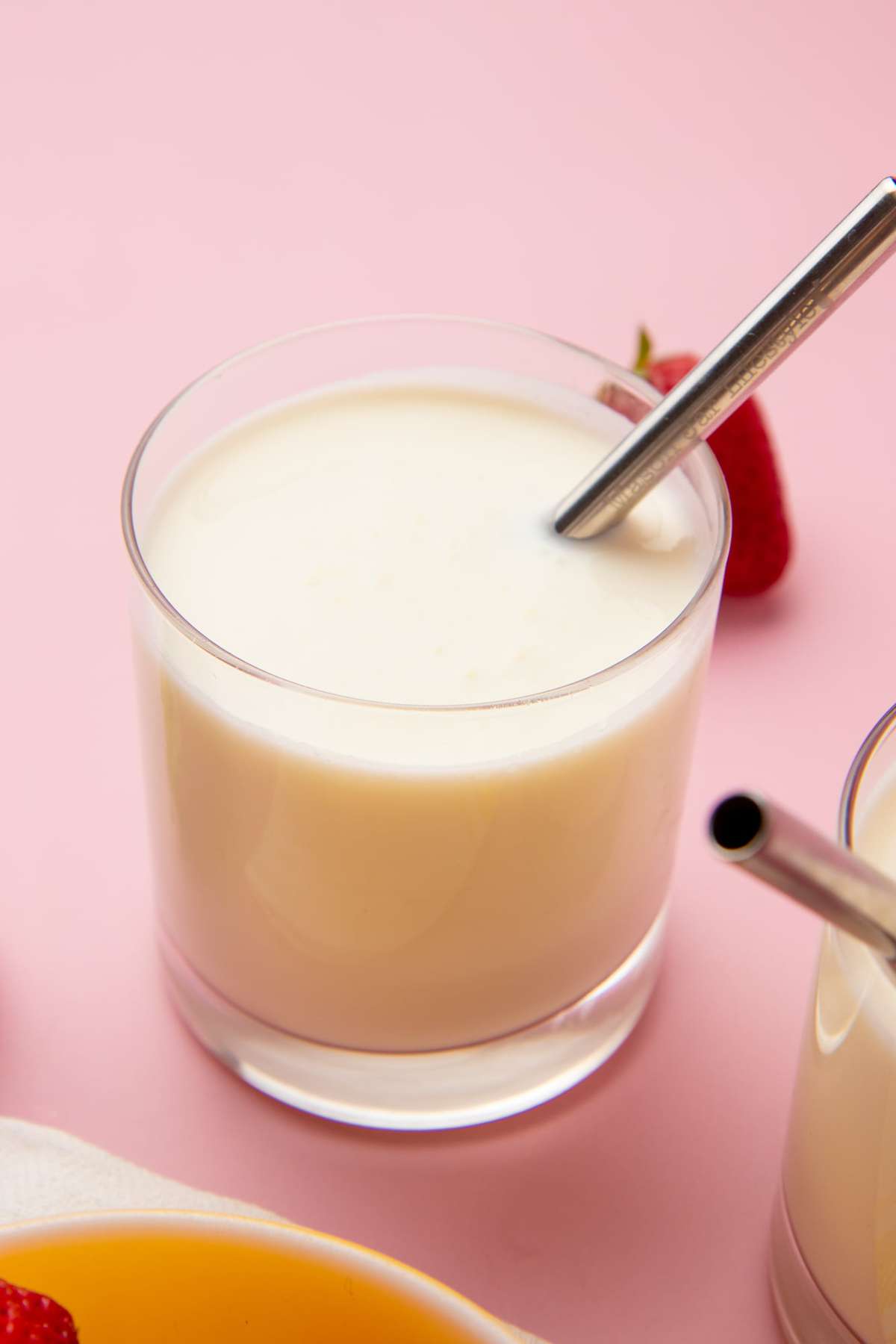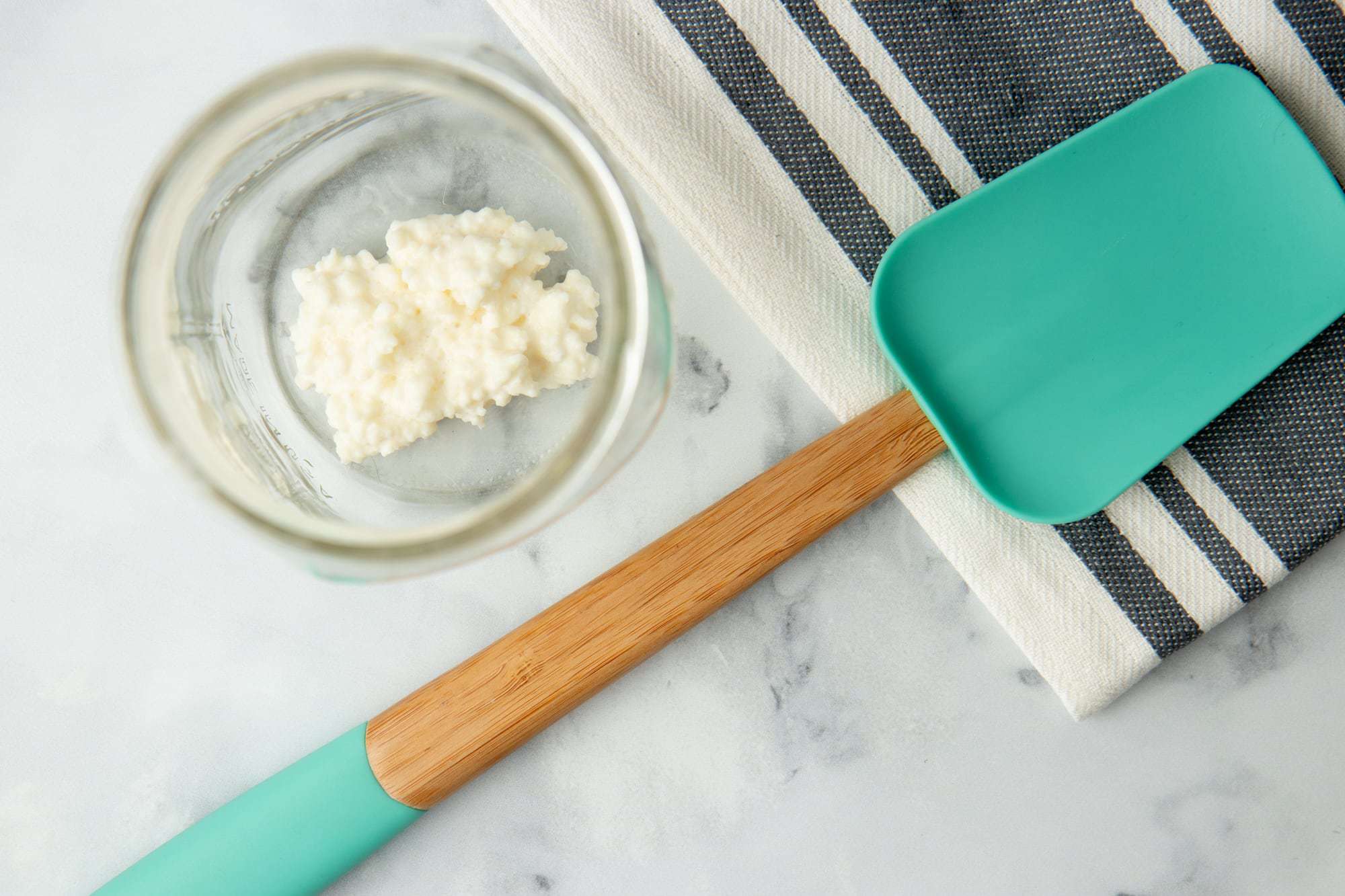We have a portion of our kitchen called “The Fermentation Station” because it seems like there is always something culturing on our countertop! One of my favorite additions to The Fermentation Station is tangy, bubbly milk kefir.
Milk kefir is something that hit the mainstream a few years back, and it happens to be one of the easiest ways to get started with fermenting in your own kitchen. Let us show you how to make your own tangy milk kefir!

First up, what is kefir?
Kefir is a fermented milk product that is the consistency of thin yogurt. But where homemade yogurt is fermented using strictly bacteria, kefir is made with “grains” made from both bacteria and beneficial yeast.
What does kefir taste like?
Like yogurt, kefir is a little bit sour and tangy, but unlike yogurt, kefir is also slightly carbonated.

Is kefir good for you?
Milk kefir is a healthy fermented food that is a great addition to a balanced diet! Fermenting the milk breaks down the lactose, making it easier to digest for some folks who struggle with dairy products. The fermentation process also adds tons of folic acid and probiotics to the kefir. Probiotics are good news for your digestive tract.
Are there other kinds of kefir other than milk kefir?
Yes! You can also make water kefir, but it requires different grains and a different process from the one we outline here.

Why should I make kefir?
If your body doesn’t love dairy, you have digestive problems, or you’re just looking for a new fermented food to try, kefir is for you. Kefir is low in lactose, and high in probiotics, to name just two of its health benefits.
My favorite thing about kefir is how flippin’ easy it is to make. There are lots of fermented foods out there (kombucha, yogurt, sourdough bread, sauerkraut, etc.), but I consider kefir the absolute easiest (and quickest!) one to make. It only requires two ingredients—milk and kefir grains—and once you have the kefir process going, you can keep it producing for as long as you like.

Where can I buy kefir grains?
To make kefir, the first thing you need to do is track down a good source of healthy kefir grains. Kefir grains are cauliflower-looking blobs of yeast and bacteria that you use to inoculate milk (and turn it into kefir).

Unless you have an awesome friend who is willing to part with some of their grains, chances are, you’ll need to order them online. There are lots of people selling kefir grains out there, but you have to be careful, because if they aren’t packed and shipped correctly, they’ll be D.O.A. I had excellent luck with my order from Fusion Teas. They came packed beautifully, were super healthy, and were reasonably-priced.
Also, make sure you aren’t buying “kefir starter.” Starter is a one-time use kind of thing and is totally different from kefir grains. If you treat your grains right, they just keep growing and growing and you’ll never have to buy them ever again. With kefir starter, you have to buy new each time you want to make a batch of kefir. Grains are where it’s at.

How do I reactivate kefir grains after shipping?
Once you have your grains, chances are, you’ll need to reactivate them from shipping. This is easy peasy. All you need to do is take milk and plop the grains in it, and let it sit at room temperature for a few hours.
For each tablespoon of kefir grains you want to reactivate, add 1/4 cup milk to a glass jar with the grains. Put on a lid (secured, but not too tight) and let it sit in a cozy part of your house. Every 12 hours, come back, strain the grains out of the milk, and then put the grains back into the jar and add fresh milk. You can use the soured milk in place of buttermilk in baking and recipes. Don’t be surprised if your fermented milk smells heavily like bread yeast—that’s a good sign!
Repeat the process every 12 hours until your grains are reactivated. You’ll know your grains are reactivated when the milk thickens in the 12 hour period. Once your grains are reactivated, you’re ready to make kefir.

What kind of milk will I need?
Your kefir grains will need lactose to feed on, so any milk with lactose is a good option. Any milk from a mammal contains lactose—cow and goat milk are both great choices. You can ferment non-animal milks (such as nut milks, coconut milk, soy milk, etc.) using kefir grains, but you’ll kill your grains in the process.
Okay, so how do you make kefir?
Making kefir takes awhile (a whole day), but that time is almost entirely hands-off. Once you have your kefir grains and milk, the only other thing you need is a glass jar with a lid.

- Add your kefir grain to a clean glass jar. You can add as many or as few grains as you have—the more kefir grains you have, the faster the kefir will be ready, and vice versa. The grains will grow slightly bigger every time you make a batch. A good rule of thumb is 1 tablespoon of grains per 1/2 cup of milk will ferment in about 12-18 hours.
- Add in your milk. Don’t fill the jar all the way to the top—leave about an inch worth of headspace.
- Secure the lid (but not too tight), and set the jar in a warm, but out-of-the-sun spot to rest.
- Within about eight hours, it should start to thicken. By 12 hours, it should be really thick. And by 18-24 hours, the kefir might start to separate into curds and whey. The longer the kefir sits and ferments, the tangier and more carbonated it will be.
- Once you are happy with the thickness and tanginess of the kefir, you can open the jar—remember, it’s carbonated now, so it’ll hiss—and strain the grains.
- I use a fine mesh sieve and a spatula to (very gently) push the kefir through while keeping the grains in the sieve.
That’s it! You can take the grains and make a new batch of kefir, or stash the grains for use later (more on that later).
Wholefully Protip
When working with kefir grains, use only glass, plastic, and stainless steel utensils, bowls and strainers. Using other reactive metals can kill your kefir grains on contact.

What if I need to slow down my milk kefir production?
Because kefir grains grow every time you make a new batch of kefir—and more grains mean faster ferments—you can pretty quickly find yourself with too much kefir to drink!
If you need to slow down your kefir production, it is easy! Instead of letting the kefir ferment on the counter, all you have to do is let it do its thing in the fridge. By fermenting the kefir in the cold, the process takes much longer—upwards of 10-14 days. And you can always restart the speedy production by bringing the grains out of the fridge again.
Wholefully Protip
If you let your kefir ferment a bit too long, you can mix the curds and whey back together just by gently shaking the jar.

How do I store kefir grains?
If you can’t keep up with your kefir production or otherwise need to take a break from making kefir, you’ll want to store your grains so that they can be reactivated and used again later.
For short term storage (up to a month): Submerge the grains in fresh milk in the refrigerator. Keep them in a cold (but not freezing) portion of your fridge. When it’s time to reactivate them, follow the same method outlined above.
For longer term storage (up to a year): Take the grains out of the milk and rinse them using unchlorinated water. Pat the grains dry gently with a paper towel, and then toss the grains in powdered dried milk. Place in a zip-top freezer bag or freezer-safe glass jar. Freeze for up to one year. To reactivate, thaw in the fridge, then follow the reactivation method from above.

How long does kefir last?
Good news: because kefir is naturally fermented, it will last longer in the fridge than a typical dairy product. You can easily get 2-3 weeks out of it without any loss of flavor or quality—which should be plenty of time to drink or otherwise use it up!
How can I use kefir?
You can use kefir any place you would use yogurt or buttermilk in recipes. Here are some of our ideas for how to use kefir:
- Overnight oats. Use milk kefir in place of yogurt in any of our well-loved overnight oats recipes!
- Healthy Blueberry Muffins. Our vegan blueberry muffins call for plant-based milk, but if you are eating dairy, milk kefir works perfectly in place of the milk and lemon juice.
- Smoothies. Milk kefir and smoothies are a match made in heaven! Use milk kefir as your liquid of choice in any of our dozens of smoothie recipes.
- Irish Soda Bread Recipe. This rustic quick bread typically uses buttermilk, but milk kefir works perfectly in place of it!
- Ranch Dressing. Swap out the buttermilk and yogurt in our healthy ranch dressing recipe for milk kefir.
- Whole Grain Pancakes. Buttermilk makes the pancakes soft and fluffy, and kefir works just the same way in the batter!

Homemade Milk Kefir
Kefir is a fermented dairy product that tastes tangy and is packed with healthy probiotics. We'll teach you how to make kefir in our step-by-step tutorial.
Ingredients
- 3 tablespoons activated kefir grains
- 1 1/2 cups milk (cow or goat milk)
Instructions
- Combine the grains with the milk in a glass pint jar.
- Put the lid on the jar (it should be secure, but not tight), and let rest at room temperature.
- Carefully open the jar after 8-12 hours and test for thickness and flavor. The longer you let the kefir ferment, the thicker and more tangy it will be.
- When you are happy with the kefir, strain out the grains.
- Pour the strained kefir into a bottle. You can now use the grains to make more kefir in a clean jar with fresh milk.
Notes
When using kefir grains, be sure to only use glass, plastic, and stainless steel. Other reactive metals can kill your kefir grains.
Nutrition Information:
Yield: 2 Serving Size: 1 cupAmount Per Serving: Calories: 104Total Fat: 4gSaturated Fat: 2gTrans Fat: 0gUnsaturated Fat: 1gCholesterol: 16mgSodium: 140mgCarbohydrates: 10gFiber: 0gSugar: 1gProtein: 7g
At Wholefully, we believe that good nutrition is about much more than just the numbers on the nutrition facts panel. Please use the above information as only a small part of what helps you decide what foods are nourishing for you.


